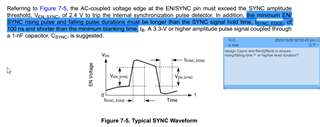Hi there
we are using this device. some questions to ask.
1. Is there internal pull-down resistor on EN pin? what is the device status if the input EN is Un-connected(floated) by mistake?
2. we use external sync to multiple TPSM63603. Section 7.3.7 mentions (blue high-lighted) that "the minimum EN/SYNC rising pulse and falling pulse durations must be longer than the SYNC signal hold time, tSYNC_EDGE , of 100 ns and shorter than the minimum blanking time, tB(4us, min).
here is my confusion: Does the "EN/SYNC rising pulse and falling pulse durations " refer to the rising/falling time (say, from 10% to 90% generally), or refer to the high / low level duration? I think it is the latter。

3. can we connect small SMT test point on SW pin, as we hope to measure switching node waveform.

4. could you please help review our desing sch.
we use 800khz ext. sync, and two IC can be enabled sequentially by connecting PG of U1 to EN of U2 (R1617), and also can be enabled at the same time by sharing net "PWR_EN2_share"(R1712)
[deleted]
thanks a lot!


